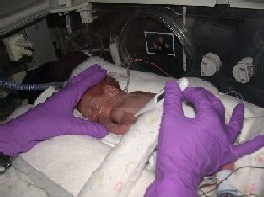Als Laboratory Research | Overview
Highlights of major accomplishments
- Demonstration that a behaviorally-based developmental care and intervention approach applied to high-risk very low birthweight (<1250g) infants is followed by improved lung function, feeding, growth, and neurobehavioral and neurophysiological function, and by a reduction in intraventricular hemorrhage.
- Demonstration that application of this approach to the much larger group of low-risk low birthweight (<2500g) infants results in improved neurobehavioral and neurophysiological function at 2 weeks post term.
- Institution of a study on small-for-gestational age premature infants using a similar neurobehavioral approach, with the addition of outcome measures on brain structure by volumetric and diffusion tensor MRI.
Major results
The development of a behaviorally-based developmental care and intervention approach referred to as Newborn Individualized Developmental Care and Assessment Program (NIDCAP) (www.nidcap.org) has been tested for infants born at <1250g birthweight, <28 weeks gestational age, in need of endotracheal ventilation in the first 24 hours and at high risk for lung disease and intraventricular hemorrhage.
We have shown that the application of NIDCAP exhibits effectiveness in terms of significantly improved lung function, reduction in intraventricular hemorrhage, feeding effectiveness, physical growth, improved neurobehavioral and brain neurophysiological functioning at two weeks after expected due date, at nine months and one year, and preliminarily at eight years. Our recent multi-center trial replicates the majority of these findings. A reflective process analysis component has identified key characteristics necessary for the successful implementation of developmental care in NICUs.
For medically low-risk, low birthweight (LBW) preterm infants (gestational age at birth <34 weeks; birthweight <2500 g) the approach has shown effectiveness in significantly improved neurobehavior and enhanced neurophysiological functioning at two weeks after expected due date, with specific benefit for attentional regulation and frontal lobe functioning. The infants receiving intervention performed as well as a full term comparison group, while the control group of preterm infants who received standard care performed more poorly than the experimental preterm and the fullterm comparison group.
 Current newborn studies focus on one further population with the goal to pursue additional specific questions concerning brain development. This population includes fetal growth restricted (FGR) preterm infants with gestational ages between 28 and 33 weeks and growth measurements <5th %ile and therewith already compromised brain development in utero. In addition to brain function (behavior and electrophysiology), brain structure will be investigated by the use of quantitative volumetric MRI determinations and diffusion tensor MR delineation of fiber tract development.
Current newborn studies focus on one further population with the goal to pursue additional specific questions concerning brain development. This population includes fetal growth restricted (FGR) preterm infants with gestational ages between 28 and 33 weeks and growth measurements <5th %ile and therewith already compromised brain development in utero. In addition to brain function (behavior and electrophysiology), brain structure will be investigated by the use of quantitative volumetric MRI determinations and diffusion tensor MR delineation of fiber tract development.
In addition, two current follow up studies aim to assess the effectiveness of the NIDCAP intervention for preterm infants at school age and adolescence. Infants in these populations were randomly assigned in the NICU to either a treatment group which received individualized developmental care or to a control group which received the standard NICU care of the time. These populations include: 1) School-aged children who were previously studied at two weeks and nine months corrected ages (CA). Half of these children were appropriate in growth for gestational age at birth (AGA) and half were FGR at birth. A group of children who were born healthy at fullterm are studied for comparison. 2) Adolescents aged 14-21 years CA who were previously studied at two weeks and nine months CA and who were born at <1250g birthweight, <28 weeks gestational age and in need of mechanical ventilation for at least 24 of the first 48 hours.
NIDCAP Federation International
To learn more, visit the Newborn Individualized Development Care and Assessment Program (NIDCAP) website.
